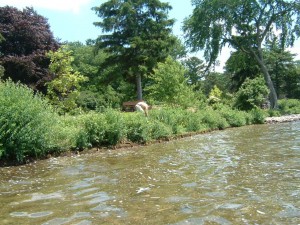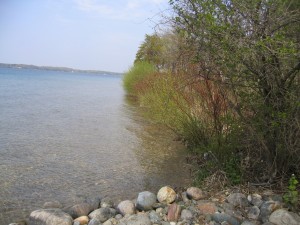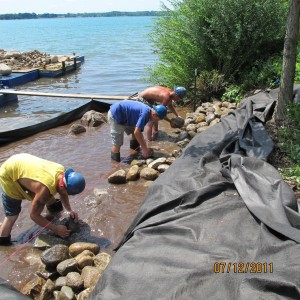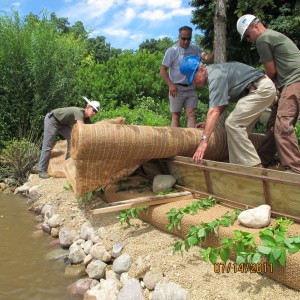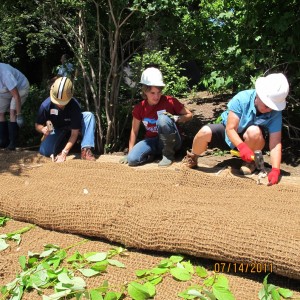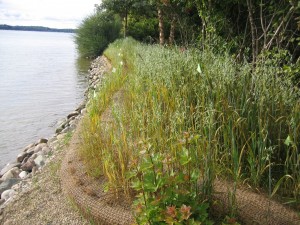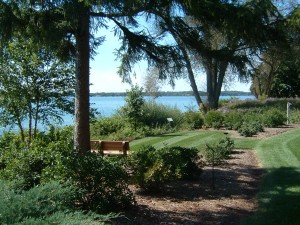Landscape Three
KBS Demonstration
Natural Shoreline Landscape Three
The following are the major features of Natural Shoreline Landscape Three (NSL Three).
Erosion Control
The shoreline of NSL Three was originally stabilized in 2002 using approximately 50 feet of encapsulated soil lift and 80 feet of live fascine.
Encapsulated soil lifts (sometimes called vegetated geogrid) – Soil lifts (Figure 3) alternate layers of topsoil, snugly wrapped in coconut blankets, with live woody shrub cuttings harvested at the dormant stage. Similar to the layer system of the live cribwall, this structure does not use logs but is constructed with forms that are removed once installation is complete. As with all of the KBS soil bioengineered structures, vegetation can be left tall for privacy screening or pruned to as low as 20 inches. A wave breaker of biodegradable coconut fiber that lasted several years protected the entire structure.
Dormant shrub cuttings created a vast root mass in the bank as they grew. By the time the coconut logs rotted away, these roots had stabilized this section of shoreline against erosion and bank loss.
Live Fascine – Live fascines (also called wattles) are made of long bundles of live native woody shrub cuttings harvested at the dormant stage, tied together with twine and placed in a shallow trench along the edge of the shoreline (Figure 2). The bundles were held in place with live willow stakes and dead stout stakes (made from untreated 2×4’s) driven through the bundles and into the bank. This technique is useful in reducing damage from ice push and slowing pollutant runoff. A coir log wave break, made of coconut fiber, protected the live fascine for several years. For construction photos from 2002 click here.
In 2007 the fascine needed a repair. Click to see photos. Unfortunately, the entire structure was unable to withstand the wave action on Gull Lake and, in 2011, was replaced with encapsulated soil lifts positioned on a rock toe.
After the remains of the old live fascine and vegetated geogrid were removed from NSL Three, the bank was rebuilt using encapsulated soil lifts on a rock base, or toe. This project could be classified as biotechnical due to the use of rock and plant material. The rock toe serves as a base on which to construct the soil lifts above the Ordinary High Water Mark. (Soil lifts are not recommended for use below the Ordinary High Water Mark).
The 18-inch high rock toe of 4” to 12-inch stone was lined with non-woven geotextile erosion control fabric. A 4” thick layer of 1 to 2-inch stone was then placed on the toe followed by a 4-inch thick layer of pea gravel to facilitate drainage. Two kinds of lifts (40-feet of each) were constructed in 2011. Click to see photos of the process. A short video of how the lifts were constructed is available here.
Photos of first year growth are available here.
Habitat Enhancement
Woody shrubs incorporated into both the shoreline and upland areas of NSL Three offer food, cover and nesting areas for a variety of shoreline birds and provide shade for fish, reptiles and amphibians. Photos showing the change in vegetation and habitat over a ten year period are available here.
Reduced Lawn Maintenance
The design of NSL Three is referred to as the “60/40”. Approximately 60 percent of the shoreline area has been converted from high maintenance turf lawn to a variety of planted woody shrubs. These shrubs require less maintenance while providing privacy from busy lake activities, or may be pruned to a height of 20 inches.
The turf grass in NSL Three is not the usual bluegrass variety. It is a long-rooted turf-type fescue that can better withstand drought and foot traffic because of its long root structures, accommodating the usual shoreline activities such as picnicking, sunbathing and yard games.
Septic Systems
In shoreline areas with poorly maintained septic systems and high water tables, sewage effluent released to groundwater can carry phosphorus and nitrogen to the lake where it can contribute to nuisance aquatic plant growth. NSL Three demonstrates the use of long root systems of turf fescue and woody shrubs that provide a zone of root structure that can help to intercept septic system nutrients before they reach the lake.
